
Wave soldering is a reliable soldering method to assemble through-hole components on printed circuit boards (PCBs). At PCBONLINE, our engineers have rich experience in designing the fixture and process parameters, and our technicians complete the wave soldering process efficiently. We use lead-free solder and a RoHS-compliant process to guarantee a strong, clean, and durable connection between the through-hole components and the PCB.
What Is Wave Soldering?
Wave soldering is a programmable soldering process to reliably connect the leads of through-hole (PTH) components to the printed circuit board assembly (PCBA). During wave soldering, the PCBA manufacturer PCBONLINE places the PCBA onto a custom fixture, and the PCBA passes over a wave of molten solder. As the board moves across the wave, the exposed component leads and the PTH hole walls are soldered in one continuous motion.
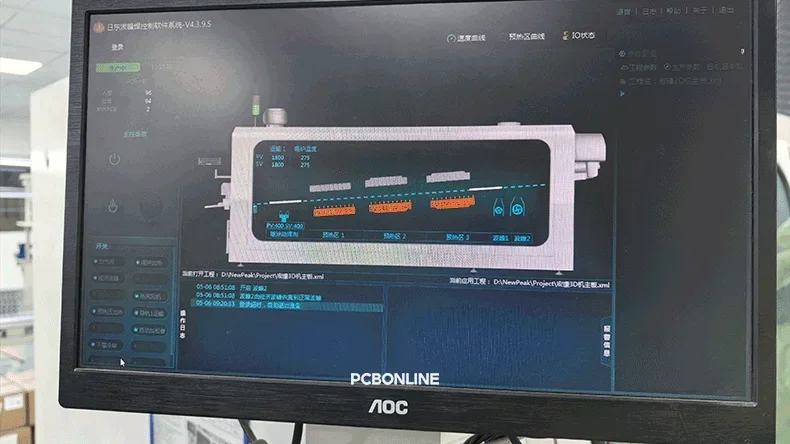
For large-volume PCB assembly that requires through-hole components, wave soldering is efficient and cost-effective. Especially, PCBONLINE's PTH/DIP lines are super efficient and professional. Our technicians sit beside the DIP line before and after the wave soldering oven, each responsible for their work, with the conveyor moving automatically, collaboratively completing the wave soldering process.
PCBONLINE's Wave Soldering Process with a Video: Step-by-Step
PCBONLINE uses a programmable wave soldering machine, a repeatedly used custom fixture, and an automated guided vehicle (AGV) on each DIP line. Below is the wave soldering process video at PCBONLINE.
Preparation before the wave soldering process
From the above video, you can find that, before the wave soldering oven, PCBONLINE's technicians insert all the component leads from the top side through the PCB into the holes in place.
Right before the wave soldering oven, a technician secures the PCBA onto a custom fixture and places it on the conveyor at the entrance of the wave soldering oven.
How does the wave soldering process work? Here are three steps in the wave soldering oven, which is programmable.

1. Flux application
First, the sprayer of the oven sprays a liquid flux onto the bottom side of the PCBA. The flux will improve soldering in the next.
2. Preheating
The PCBA moves through the preheating zone to gradually raise its temperature. It activates the flux, evaporates solvents, and reduces thermal shock in soldering.
Temperature: 100°C–130°C.
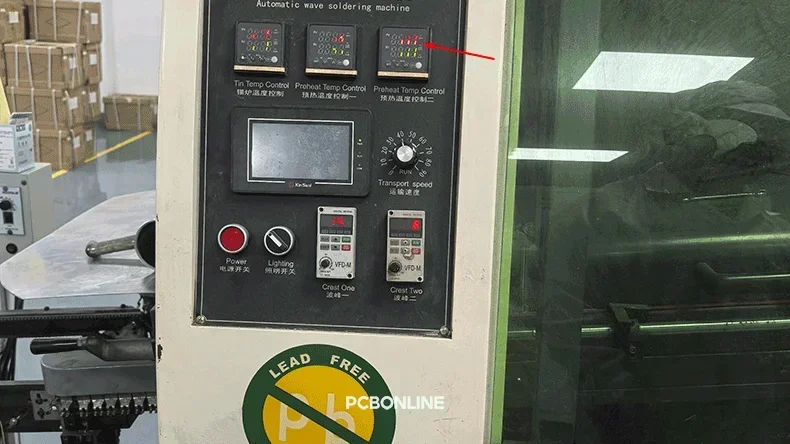
From the above picture of the wave soldering oven interface at PCBONLINE, the preheating temperature is 111°C.
3. Wave soldering
In the molten solder pot, the PCBA passes over a turbulent wave for about 10 seconds. The solder adheres to the component leads and the PCB PTH hole walls, forming permanent electrical connections. Then the PCBA leaves the wave soldering oven.
Temperature: Maintained at 250°C–260°C.
The liquid solder alloy: Lead-free SAC305 (Sn96.5/Ag3.0/Cu0.5) is standard at PCBONLINE.

After wave soldering
A technician sitting right after the wave soldering oven takes the PCBA from the conveyor and releases it from the fixture.
She puts the fixture on the AGV, which cutely sends the fixture to the previous technician for the next PCBA for wave soldering.
Besides, this technician trims the leads on the downside to be 1-2mm.
What Makes PCBONLINE Have Advantages in Wave Soldering?
You have learned about the wave soldering process, and you may wonder, since wave soldering and the PTH assembly are so clear and standard, what makes the difference in partnering with different PCBA manufacturers?
Well, it makes a difference in the custom fixture and the DIP line work mode.
PCBONLINE has advantages in custom fixture design and the arrangement of the DIP line.
Custom fixture design to prevent component displacements
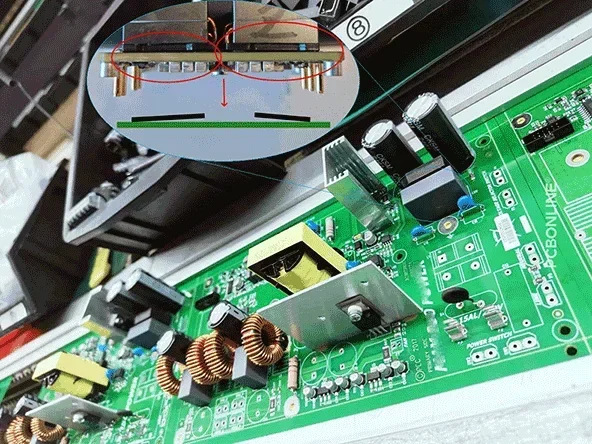
During wave soldering, the component flotation issue may happen due to improper manual component placement and the thermal expansion of solder.
PCBONLINE prevents this problem with dedicated fixture design.
Our custom-designed fixtures not only protect the PCBA from high temperatures but also press down on components prone to movement during soldering.
Besides, if the fixture can't press down on the component, the alternative soldering method for PTH components, selective soldering, is also available at PCBONLINE. Though selective soldering features a lower efficiency and higher costs, it can prevent thermal shocks and component displacements.
Apart from fixture design and selective soldering, PCBONLINE can optimize your PCB design for the smooth wave soldering process. For components requiring high positional accuracy, such as buttons and sockets that must align precisely with the enclosure, we can apply a layer of adhesive to the component's bottom before soldering. It can effectively mitigate component displacements.
Efficient DIP line arrangement
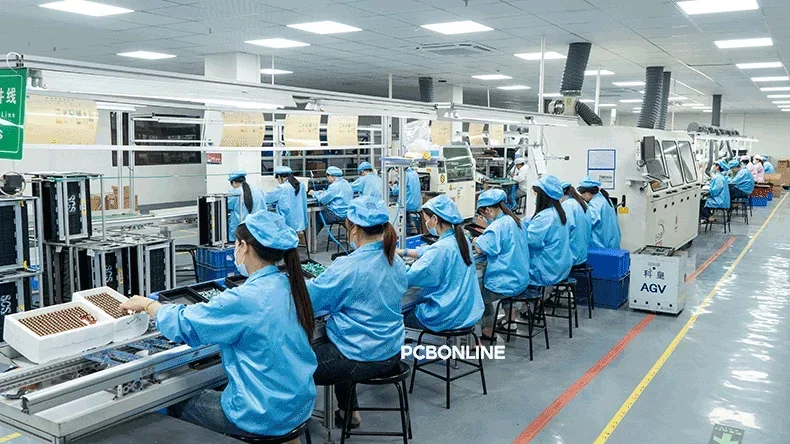
If you've watched PCBONLINE's wave soldering process video above, you can notice that the DIP line is very efficient.
PCBONLINE's dedicated DIP lines are half automated — manual operations, automated conveyors, an AGV, and an automated wave soldering oven.
Each technician only focuses on plugging in a specific type of PTH component on the PCBA. And after wave soldering, each technician is only responsible for a process, including lead trimming, cleaning flux residue, touch-up, visual inspection, functional testing, programming, and packaging.
Advantages of PCBONLINE's Wave Soldering Service
PCBONLINE offers turnkey PCB assembly services, including PCB fabrication, PCB assembly (wave soldering is part of it), testing, value-added, and box build and final assembly.
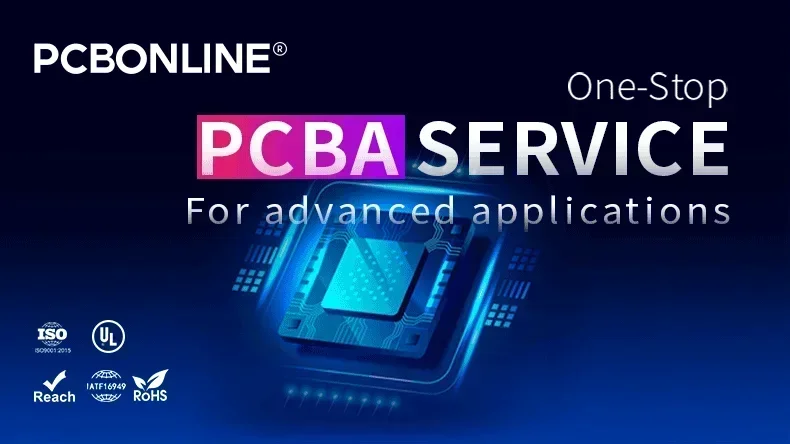
PCBONLINE is an OEM PCB source factory manufacturer founded in 1999. We have two large advanced PCB manufacturing bases, one turnkey PCB assembly factory, stable supply chains, and an R&D team.
PCBONLINE maintains long-term cooperation with the top 3 fixture/enclosure manufacturers in China. The wave soldering fixtures are manufactured accurately.
The experienced engineers at PCBONLINE design the dedicated fixtures to perfectly fit wave soldering requirements.
We provide one-stop PCBA manufacturing from prototypes to mass production.
Our team provides one-on-one support, solving technical and non-technical challenges while offering optimization suggestions to ensure your project runs smoothly from start to finish.
High-quality PCBA manufacturing certified with ISO 9001:2015, ISO 14001:2015, IATF 16949:2016, RoHS, REACH, UL, and IPC-A-610 Class 2/3.
When your project enters the bulky production stage, PCBONLINE refunds the fees of prototyping and offers free PCBA functional testing.
PCBONLINE provides wave soldering for applications of:
- Industrial controllers and power modules
- Military or aerospace boards requiring robust connections
- Automotive and consumer electronics with traditional PTH component footprints
No matter what quantity of PCBAs you order, PCBONLINE prioritizes quality. To get a quote from the one-stop PCBA manufacturer PCBONLINE, contact info@pcbonline.com.
Conclusion
PCBONLINE provides wave soldering services precisely and efficiently. To ensure the success of your PCB/PCBA projects, get a quote or consult with our engineers for your THT assembly needs.
PCB assembly at PCBONLINE.pdf




